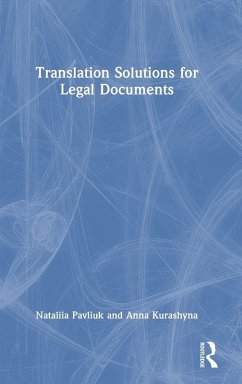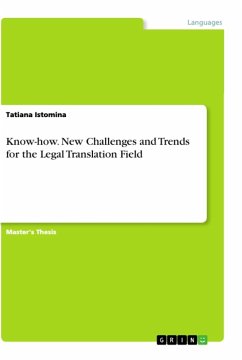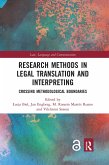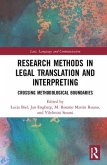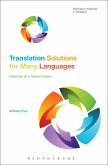- Gebundenes Buch
- Merkliste
- Auf die Merkliste
- Bewerten Bewerten
- Teilen
- Produkt teilen
- Produkterinnerung
- Produkterinnerung
The course book covers the legal translation themes by the types of legal documents. The three parts of the book are devoted to the translation of legislative documents, contracts, and court documentation.
Andere Kunden interessierten sich auch für
![Know-how. New Challenges and Trends for the Legal Translation Field Know-how. New Challenges and Trends for the Legal Translation Field]() Tatiana IstominaKnow-how. New Challenges and Trends for the Legal Translation Field27,95 €
Tatiana IstominaKnow-how. New Challenges and Trends for the Legal Translation Field27,95 €![Localization in Translation Localization in Translation]() Miguel A. Jiménez-CrespoLocalization in Translation172,99 €
Miguel A. Jiménez-CrespoLocalization in Translation172,99 €![Selected Babylonian Business and Legal Documents of the Hammurabi Period Selected Babylonian Business and Legal Documents of the Hammurabi Period]() Arthur UngnadSelected Babylonian Business and Legal Documents of the Hammurabi Period29,99 €
Arthur UngnadSelected Babylonian Business and Legal Documents of the Hammurabi Period29,99 €![Babylonian Legal and Business Documents From the Time of the First Dynasty of Babylon Babylonian Legal and Business Documents From the Time of the First Dynasty of Babylon]() Hermann RankeBabylonian Legal and Business Documents From the Time of the First Dynasty of Babylon31,99 €
Hermann RankeBabylonian Legal and Business Documents From the Time of the First Dynasty of Babylon31,99 €![Research Methods in Legal Translation and Interpreting Research Methods in Legal Translation and Interpreting]() Research Methods in Legal Translation and Interpreting54,99 €
Research Methods in Legal Translation and Interpreting54,99 €![Research Methods in Legal Translation and Interpreting Research Methods in Legal Translation and Interpreting]() Research Methods in Legal Translation and Interpreting168,99 €
Research Methods in Legal Translation and Interpreting168,99 €![Translation Solutions for many languages Translation Solutions for many languages]() Anthony PymTranslation Solutions for many languages157,99 €
Anthony PymTranslation Solutions for many languages157,99 €-
-
-
The course book covers the legal translation themes by the types of legal documents. The three parts of the book are devoted to the translation of legislative documents, contracts, and court documentation.
Produktdetails
- Produktdetails
- Verlag: Routledge
- Seitenzahl: 246
- Erscheinungstermin: 19. August 2025
- Englisch
- Abmessung: 240mm x 161mm x 18mm
- Gewicht: 537g
- ISBN-13: 9781032762951
- ISBN-10: 1032762950
- Artikelnr.: 72879110
- Herstellerkennzeichnung
- Libri GmbH
- Europaallee 1
- 36244 Bad Hersfeld
- gpsr@libri.de
- Verlag: Routledge
- Seitenzahl: 246
- Erscheinungstermin: 19. August 2025
- Englisch
- Abmessung: 240mm x 161mm x 18mm
- Gewicht: 537g
- ISBN-13: 9781032762951
- ISBN-10: 1032762950
- Artikelnr.: 72879110
- Herstellerkennzeichnung
- Libri GmbH
- Europaallee 1
- 36244 Bad Hersfeld
- gpsr@libri.de
Nataliia Pavliuk is a British Academy Research Fellow at the University of Leeds, UK (researcher in the field of legal translation studies), and Associate Professor (Ukraine). Her course involvement includes Introduction to Legal Translation, Genres in Translation, and Translation in International Organisations. She is an English-Ukrainian legal translator, entrepreneur, and chairperson of the Ukrainian Association of Translators and Interpreters. Anna Kurashyna is Assistant Professor at the National University of Kyiv-Mohyla Academy, Ukraine (English for Specific Purposes (ESP) lecturer and researcher in the field of legal English and translation). Her courses include English for Specific Purposes. She is an English-Ukrainian legal translator and board member of the Ukrainian Association of Translators and Interpreters.
List of tables
List of figures
Preface
Acknowledgements
Introduction
1 Legal translation today - between law, language, and technologies
1.1 Practical aspects of legal translation
1.2 Legal systems and translation
1.3 Translation strategies and techniques
1.4 Modern technologies in translation
Part 1 Translating legislation
2 General information about legislation and its translation
2.1 The purpose of legislation and its translation
2.2 Structure, classification, and hierarchy of legislative texts
2.3 A translator of legislation
2.4 When legislative acts need to be translated
3 Translating EU legislative acts
3.1 Types and general characteristics of EU legislative acts
3.2 Machine translation in EU institutions
3.3 Challenges of translating titles, subject matter, scope, and
definitions of EU legislative acts
3.4 Exercises
4 Translating UK legislation
4.1 Primary and secondary legislation in UK law
4.2 Structure and linguistic characteristics of Acts of Parliament of the
UK, Scotland, and Northern Ireland
4.3 Translating different structural parts of UK legislative acts
4.4 Grammatical issues of translating UK legislation: infinitive phrases
and clauses
4.5 Exercises
5 Translating US legislation
5.1 The hierarchy of US legislative acts
5.2 Translating the Constitution
5.3 Grammatical challenges of translating passive voice structures
5.4 Exercises
Part 2 Translating contracts
6 General information about contracts and their translation
6.1 The nature of contracts
6.2 The goals of signing contracts
6.3 Contracts in common and civil law jurisdictions
6.4 Structural elements of the contract
6.5 Language of contracts and translation problems
6.6 When contracts need to be translated
7 Translating contracts for an unlimited number of users
7.1 Types of contracts for an unlimited number of users
7.2 The functions of a website's "Terms of Use"
7.3 Common provisions included in the "Terms of Use"
7.4 Translation of contracts with an indefinite number of users
7.5 Language categories. Language of obligation, permission, and
prohibition
7.6 Limitation of liability and disclaimer clauses
7.7 Exercises
8 Translating service provision contracts
8.1 Functions and goals of the service contract
8.2 Common clauses and structures of service provision contracts
8.3 Challenges of translating service provision contracts. Titles
8.4 An introductory clause and its translation
1. Language of performance as a translation problem
8.6 Exercises
9 Translating building construction contracts
9.1 Specific features of a building construction contract
9.2 Common provisions and structure of a building construction contract
9.3 Archaic words and phrases in legal English as a translation problem
9.4 Noun premodification as a specific feature of the English language and
methods of its translation
9.5 Exercises
Part 3 Translating court judgments and opinions
10 General information about courts and court documents
10.1 Functions of courts and court documents
10.2 Court documents in different law systems
10.3 Definitions of "judgment"
10.4 When court judgments and opinions need to be translated
11 Translating judgments of the European Court of Human Rights
11.1 The history, jurisdiction, and structure of the European Court of
Human Rights
11.2 Structural parts of ECtHR judgments and their translation
11.3 Translation of the circumstances of the case as a narrative
11.4 Relevant legal framework and practice and the "Law" section
11.5 Grammatical challenges of translating ECtHR judgments: tense forms of
the verbs in different sections of the judgment
11.6 Exercises
12 Translating UK court judgments
12.1 UK judicial system, structure, and hierarchy
12.2 Participants in the proceedings
12.3 Pre-translation analysis of the judgment
12.4 Structural elements of UK judgments and their translation
12.5 Exercises
13 Translating US Supreme Court opinions
13.1 The judicial system of the United States
13.2 Judicial opinion as a post-trial document: definition and types
13.3 Common structural elements of the US judicial opinions and how to
understand them to translate properly
13.4 References and citations: how to understand abbreviations and
translate them correctly
13.5 Participants in the US Supreme Court
13.6 Grammatical challenges of translating gerunds and gerundial structures
13.7 Exercises
Glossary
Grammatical topics
Index
List of figures
Preface
Acknowledgements
Introduction
1 Legal translation today - between law, language, and technologies
1.1 Practical aspects of legal translation
1.2 Legal systems and translation
1.3 Translation strategies and techniques
1.4 Modern technologies in translation
Part 1 Translating legislation
2 General information about legislation and its translation
2.1 The purpose of legislation and its translation
2.2 Structure, classification, and hierarchy of legislative texts
2.3 A translator of legislation
2.4 When legislative acts need to be translated
3 Translating EU legislative acts
3.1 Types and general characteristics of EU legislative acts
3.2 Machine translation in EU institutions
3.3 Challenges of translating titles, subject matter, scope, and
definitions of EU legislative acts
3.4 Exercises
4 Translating UK legislation
4.1 Primary and secondary legislation in UK law
4.2 Structure and linguistic characteristics of Acts of Parliament of the
UK, Scotland, and Northern Ireland
4.3 Translating different structural parts of UK legislative acts
4.4 Grammatical issues of translating UK legislation: infinitive phrases
and clauses
4.5 Exercises
5 Translating US legislation
5.1 The hierarchy of US legislative acts
5.2 Translating the Constitution
5.3 Grammatical challenges of translating passive voice structures
5.4 Exercises
Part 2 Translating contracts
6 General information about contracts and their translation
6.1 The nature of contracts
6.2 The goals of signing contracts
6.3 Contracts in common and civil law jurisdictions
6.4 Structural elements of the contract
6.5 Language of contracts and translation problems
6.6 When contracts need to be translated
7 Translating contracts for an unlimited number of users
7.1 Types of contracts for an unlimited number of users
7.2 The functions of a website's "Terms of Use"
7.3 Common provisions included in the "Terms of Use"
7.4 Translation of contracts with an indefinite number of users
7.5 Language categories. Language of obligation, permission, and
prohibition
7.6 Limitation of liability and disclaimer clauses
7.7 Exercises
8 Translating service provision contracts
8.1 Functions and goals of the service contract
8.2 Common clauses and structures of service provision contracts
8.3 Challenges of translating service provision contracts. Titles
8.4 An introductory clause and its translation
1. Language of performance as a translation problem
8.6 Exercises
9 Translating building construction contracts
9.1 Specific features of a building construction contract
9.2 Common provisions and structure of a building construction contract
9.3 Archaic words and phrases in legal English as a translation problem
9.4 Noun premodification as a specific feature of the English language and
methods of its translation
9.5 Exercises
Part 3 Translating court judgments and opinions
10 General information about courts and court documents
10.1 Functions of courts and court documents
10.2 Court documents in different law systems
10.3 Definitions of "judgment"
10.4 When court judgments and opinions need to be translated
11 Translating judgments of the European Court of Human Rights
11.1 The history, jurisdiction, and structure of the European Court of
Human Rights
11.2 Structural parts of ECtHR judgments and their translation
11.3 Translation of the circumstances of the case as a narrative
11.4 Relevant legal framework and practice and the "Law" section
11.5 Grammatical challenges of translating ECtHR judgments: tense forms of
the verbs in different sections of the judgment
11.6 Exercises
12 Translating UK court judgments
12.1 UK judicial system, structure, and hierarchy
12.2 Participants in the proceedings
12.3 Pre-translation analysis of the judgment
12.4 Structural elements of UK judgments and their translation
12.5 Exercises
13 Translating US Supreme Court opinions
13.1 The judicial system of the United States
13.2 Judicial opinion as a post-trial document: definition and types
13.3 Common structural elements of the US judicial opinions and how to
understand them to translate properly
13.4 References and citations: how to understand abbreviations and
translate them correctly
13.5 Participants in the US Supreme Court
13.6 Grammatical challenges of translating gerunds and gerundial structures
13.7 Exercises
Glossary
Grammatical topics
Index
List of tables
List of figures
Preface
Acknowledgements
Introduction
1 Legal translation today - between law, language, and technologies
1.1 Practical aspects of legal translation
1.2 Legal systems and translation
1.3 Translation strategies and techniques
1.4 Modern technologies in translation
Part 1 Translating legislation
2 General information about legislation and its translation
2.1 The purpose of legislation and its translation
2.2 Structure, classification, and hierarchy of legislative texts
2.3 A translator of legislation
2.4 When legislative acts need to be translated
3 Translating EU legislative acts
3.1 Types and general characteristics of EU legislative acts
3.2 Machine translation in EU institutions
3.3 Challenges of translating titles, subject matter, scope, and
definitions of EU legislative acts
3.4 Exercises
4 Translating UK legislation
4.1 Primary and secondary legislation in UK law
4.2 Structure and linguistic characteristics of Acts of Parliament of the
UK, Scotland, and Northern Ireland
4.3 Translating different structural parts of UK legislative acts
4.4 Grammatical issues of translating UK legislation: infinitive phrases
and clauses
4.5 Exercises
5 Translating US legislation
5.1 The hierarchy of US legislative acts
5.2 Translating the Constitution
5.3 Grammatical challenges of translating passive voice structures
5.4 Exercises
Part 2 Translating contracts
6 General information about contracts and their translation
6.1 The nature of contracts
6.2 The goals of signing contracts
6.3 Contracts in common and civil law jurisdictions
6.4 Structural elements of the contract
6.5 Language of contracts and translation problems
6.6 When contracts need to be translated
7 Translating contracts for an unlimited number of users
7.1 Types of contracts for an unlimited number of users
7.2 The functions of a website's "Terms of Use"
7.3 Common provisions included in the "Terms of Use"
7.4 Translation of contracts with an indefinite number of users
7.5 Language categories. Language of obligation, permission, and
prohibition
7.6 Limitation of liability and disclaimer clauses
7.7 Exercises
8 Translating service provision contracts
8.1 Functions and goals of the service contract
8.2 Common clauses and structures of service provision contracts
8.3 Challenges of translating service provision contracts. Titles
8.4 An introductory clause and its translation
1. Language of performance as a translation problem
8.6 Exercises
9 Translating building construction contracts
9.1 Specific features of a building construction contract
9.2 Common provisions and structure of a building construction contract
9.3 Archaic words and phrases in legal English as a translation problem
9.4 Noun premodification as a specific feature of the English language and
methods of its translation
9.5 Exercises
Part 3 Translating court judgments and opinions
10 General information about courts and court documents
10.1 Functions of courts and court documents
10.2 Court documents in different law systems
10.3 Definitions of "judgment"
10.4 When court judgments and opinions need to be translated
11 Translating judgments of the European Court of Human Rights
11.1 The history, jurisdiction, and structure of the European Court of
Human Rights
11.2 Structural parts of ECtHR judgments and their translation
11.3 Translation of the circumstances of the case as a narrative
11.4 Relevant legal framework and practice and the "Law" section
11.5 Grammatical challenges of translating ECtHR judgments: tense forms of
the verbs in different sections of the judgment
11.6 Exercises
12 Translating UK court judgments
12.1 UK judicial system, structure, and hierarchy
12.2 Participants in the proceedings
12.3 Pre-translation analysis of the judgment
12.4 Structural elements of UK judgments and their translation
12.5 Exercises
13 Translating US Supreme Court opinions
13.1 The judicial system of the United States
13.2 Judicial opinion as a post-trial document: definition and types
13.3 Common structural elements of the US judicial opinions and how to
understand them to translate properly
13.4 References and citations: how to understand abbreviations and
translate them correctly
13.5 Participants in the US Supreme Court
13.6 Grammatical challenges of translating gerunds and gerundial structures
13.7 Exercises
Glossary
Grammatical topics
Index
List of figures
Preface
Acknowledgements
Introduction
1 Legal translation today - between law, language, and technologies
1.1 Practical aspects of legal translation
1.2 Legal systems and translation
1.3 Translation strategies and techniques
1.4 Modern technologies in translation
Part 1 Translating legislation
2 General information about legislation and its translation
2.1 The purpose of legislation and its translation
2.2 Structure, classification, and hierarchy of legislative texts
2.3 A translator of legislation
2.4 When legislative acts need to be translated
3 Translating EU legislative acts
3.1 Types and general characteristics of EU legislative acts
3.2 Machine translation in EU institutions
3.3 Challenges of translating titles, subject matter, scope, and
definitions of EU legislative acts
3.4 Exercises
4 Translating UK legislation
4.1 Primary and secondary legislation in UK law
4.2 Structure and linguistic characteristics of Acts of Parliament of the
UK, Scotland, and Northern Ireland
4.3 Translating different structural parts of UK legislative acts
4.4 Grammatical issues of translating UK legislation: infinitive phrases
and clauses
4.5 Exercises
5 Translating US legislation
5.1 The hierarchy of US legislative acts
5.2 Translating the Constitution
5.3 Grammatical challenges of translating passive voice structures
5.4 Exercises
Part 2 Translating contracts
6 General information about contracts and their translation
6.1 The nature of contracts
6.2 The goals of signing contracts
6.3 Contracts in common and civil law jurisdictions
6.4 Structural elements of the contract
6.5 Language of contracts and translation problems
6.6 When contracts need to be translated
7 Translating contracts for an unlimited number of users
7.1 Types of contracts for an unlimited number of users
7.2 The functions of a website's "Terms of Use"
7.3 Common provisions included in the "Terms of Use"
7.4 Translation of contracts with an indefinite number of users
7.5 Language categories. Language of obligation, permission, and
prohibition
7.6 Limitation of liability and disclaimer clauses
7.7 Exercises
8 Translating service provision contracts
8.1 Functions and goals of the service contract
8.2 Common clauses and structures of service provision contracts
8.3 Challenges of translating service provision contracts. Titles
8.4 An introductory clause and its translation
1. Language of performance as a translation problem
8.6 Exercises
9 Translating building construction contracts
9.1 Specific features of a building construction contract
9.2 Common provisions and structure of a building construction contract
9.3 Archaic words and phrases in legal English as a translation problem
9.4 Noun premodification as a specific feature of the English language and
methods of its translation
9.5 Exercises
Part 3 Translating court judgments and opinions
10 General information about courts and court documents
10.1 Functions of courts and court documents
10.2 Court documents in different law systems
10.3 Definitions of "judgment"
10.4 When court judgments and opinions need to be translated
11 Translating judgments of the European Court of Human Rights
11.1 The history, jurisdiction, and structure of the European Court of
Human Rights
11.2 Structural parts of ECtHR judgments and their translation
11.3 Translation of the circumstances of the case as a narrative
11.4 Relevant legal framework and practice and the "Law" section
11.5 Grammatical challenges of translating ECtHR judgments: tense forms of
the verbs in different sections of the judgment
11.6 Exercises
12 Translating UK court judgments
12.1 UK judicial system, structure, and hierarchy
12.2 Participants in the proceedings
12.3 Pre-translation analysis of the judgment
12.4 Structural elements of UK judgments and their translation
12.5 Exercises
13 Translating US Supreme Court opinions
13.1 The judicial system of the United States
13.2 Judicial opinion as a post-trial document: definition and types
13.3 Common structural elements of the US judicial opinions and how to
understand them to translate properly
13.4 References and citations: how to understand abbreviations and
translate them correctly
13.5 Participants in the US Supreme Court
13.6 Grammatical challenges of translating gerunds and gerundial structures
13.7 Exercises
Glossary
Grammatical topics
Index

